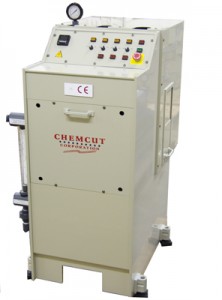Regeneration for Copper Chloride and Ferric Chloride Etching
Product Lines for Etchant Regeneration
Etchant Regeneration Systems We Offer
Chlorine Gas
Sodium Chlorate and Hydrochloric Acid
Hydrogen Peroxide and Hydrochloric Acid (Cupric Chloride Only)
Chemcut patented the etchant regeneration process nearly 50 years ago (Patent #3,526,560) and, since that time, has delivered approximately 1,000 copper chloride (cupric chloride) and ferric chloride regeneration systems worldwide.
Adding a regeneration system to your metal etching system will extend the life of a ferric chloride metal etcher by 3-fold.
Adding a regeneration system to your cupric chloride metal etcher will extend the etchant’s life forever. As long as the dosing is correct, and we will help you set the dosing up correctly so the etchant for copper etching will last forever.
Chemistry Regeneration Capacity
0 – 1,000 pounds of metal per day
Can build systems to handle larger amounts of metal per day if needed
All Chemcut acid regeneration systems for copper and ferric chloride utilize oxidation-reduction potential (ORP) and specific gravity control.
Automatic control of the hydrochloric acid content is optional.
System Controls for Chemistries That Cannot be Regenerated
In addition to Chemcut acid regeneration systems for copper and ferric chloride acid, Chemcut offers system-integrated chemistry control systems for ammonia-based etchants, micro-etch applications, developer, stripping, chemical cleaning, and many other solutions.
The following automatic chemistry control systems listed below are the most common, but not the only systems we can build.
Bath Control (feed and bleed system)
pH Control
Panel Count
How does the Regeneration of etchant work?
A short explanation is, etching metal causes the metal content in solution to increase. If you want the solution to keep etching metal, you need to replace the chemicals that are being depleted by etching.
Etching metal with cupric chloride and ferric chloride causes the ORP to decrease and the Free Acid to decrease. The ORP and Free Acid are very important to maintaining a working etching bath and stopping the chemistry from crystalizing.
To cause a regeneration reaction, a specific mixture of chemicals is added to the spent/used etchant and that makes the etchant active again. For cupric and ferric chloride, the specific mixtures create chlorine gas and it reacts with the used etchant to restore it back to its active phase.
This extends the life of etchant significantly and is an easy process to implement when using a Chemcut system. The specific mixtures used to regenerate cupric and ferric are explained below.
Chlorine Gas
Regeneration using chlorine gas is the simplest system when it comes to chemistry. Chlorine gas is pumped into the cupric chloride or ferric chloride. The chlorine gas reacts with the spent etchant to regenerate the free acid and cupric or ferric chloride.
Chlorine gas systems will need a water input as well to keep the specific gravity under control. Then the etchant is ready to etch metal.
Sodium Chlorate
Using our sodium chlorate system is more complicated when it comes to chemistry but is not difficult if you are using a Chemcut system. Sodium chlorate, hydrochloric acid, and water are all pumped into the bath.
The sodium chlorate and hydrochloric acid react to create chlorine gas. The chlorine gas then reacts with the used acid to regenerate the free acid and etchant to make the etchant active again and ready for metal etching.
Hydrogen Peroxide (Copper Chloride Etching Only)
This regeneration system only works for copper chloride and has two different chemistries like sodium chlorate.
Hydrogen peroxide and hydrochloric acid will be the two chemistries pumped into the bath. The hydrogen peroxide and hydrochloric acid will react creating chlorine gas and water. The chlorine, like the two reactions above, will make the used etchant active again and the water will keep the specific gravity down. Making the acid ready to etch metal again.
If you would like more information on the copper chloride formula and ferric chloride formula, please contact us. We can explain the exact reaction that takes place regenerating the copper etchant to the original copper chloride formula. The same goes for the ferric reaction when etching stainless steel and other metals.
Chemistry Parameter Recommendations When Using Regeneration
ORP. For both cupric chloride and ferric chloride, we recommend keeping the ORP within 550 – 590. It is not uncommon for chemical millers to run ferric chloride at 600.
Free Acid. For cupric chloride etching, we recommend keeping the free acid level between 1 – 2N HCl.
Ferric chloride is extremely difficult to measure once the chemistry is used. We recommend doing a visual check through the sight glass. Ferric chloride will become turbid when the acid level is low.
Analytical methods are available to determine free acid in ferric chloride using fairly simple titrations.
If you are specifying a new etcher, a regeneration system for your new etcher can be built into the etchant chamber(s) rather than as a free-standing unit.
If you are adding regeneration to an existing etcher, you will need to have an idea of your expected metal loading so a properly sized system can be recommended.








